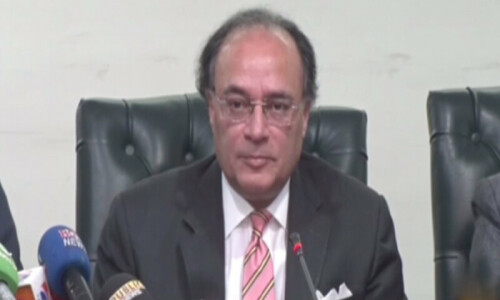Perhaps Sohni, the snow leopard who recently died at the Peshawar Zoo, had his fate sealed the day he was brought as a cub to Pakistan.
The story that has now become a legend in the mountain resort of Nathia Gali is that Shahbaz Sharif’s eldest son, Hamza Sharif, was allegedly gifted a snow leopard cub from a source in Central Asia.
Never mind that gifting a snow leopard was completely illegal since the Convention on the International Trade against Endangered Species, to which Pakistan is signatory, bans the trade of endangered animals or their body parts.
The cub was reportedly well fed in the six months that he was kept in Doonga Gali. Shortly afterwards, in 2009, WWF-Pakistan learnt about the endangered animal being kept in illegal captivity and approached its owner, convincing him to hand the animal over to a local zoo without any publicity.
Sohni was taken to the Lalazar Wildlife Park, having been claimed by the Khyber Pakhtunkhwa (KP) Wildlife Department, as Nathia Gali falls in KP.
That was where I first met Sohni, in 2012. He was living in what was literally a birdcage for pheasants hurriedly readied for the snow leopard when he arrived.

I wrote about it to raise the issue in the media. I contacted several NGOs, including WWF-Pakistan, who all told me that it was out of their hands and that they could only “advise” the KP government to build a proper enclosure for the animal.
I met with the KP wildlife officials – they assured me that funding was in the pipeline and a better and bigger enclosure would be built soon. Later, the cage was widened.
At the time, Sohni was the only snow leopard in captivity in Pakistan, and it broke my heart to see him being treated so badly.
He would lie listlessly in the small woodshed covered with a corrugated iron sheet inside the birdcage, occasionally flipping his long tail to swat away flies.
A WWF official working at the Ayubia National Park alleged that they were barely feeding him, although the wildlife department was making good money from all the visitors who were climbing up to Lalazar to see the magnificent big cat.
In zoos abroad, snow leopards are often the star exhibit and a lot of money is spent on their enclosures, as in the Bronx Zoo in New York, where Leo, a Pakistani-born snow leopard is living in luxury.
Of course, the Lalazar Wildlife Park cannot offer such comforts, but surely they could have done more. I found out later that a better enclosure that would have given Sohni some dignity had never been in the pipeline.
After several years of delays and shuttling Sohni between Lalazar (which is covered deep in snow in winter) and a cage in Abbottabad, there came a mad-cap scheme to get him installed in the hurriedly-completed Peshawar Zoo, where he was eventually shifted to in December 2017.
When the Pakistan Tehreek-i-Insaf came to power in KP in 2013, I had lobbied them to do something for Sohni. Never in my dreams had I imagined that the solution they had in mind was for him to be exhibited at the hot and dusty Peshawar Zoo!
They had assured me that they would consider the Chitral Gol National Park as a possible site for an enclosure. Indeed, a snow leopard cub found abandoned at the Khunjerab National Park in 2014 had successfully been shifted to a purpose-built enclosure in Naltar in Gilgit-Baltistan in 2016, designed with the help of the Snow Leopard Foundation (SLF)
Ali Nawaz, the director of the SLF in Pakistan, had offered technical support in designing a similar enclosure of international standards for Sohni, but to no avail.
Then came the idea of a zoo in Peshawar, to be completed by 2020. The plan was apparently fast tracked so that it could open well before the 2018 elections to gain political points.
Related: Peshawar Zoo a death cell for animals
Why was there even need for a zoo? Why not a sanctuary or a reserve where animals can roam freely? This is what Adil Zareef, founder of the Sarhad Conservation Network who protested against the zoo from day one, demands to know.
Zareef informed me that there is no trained staff at the Peshawar Zoo and the visitors also mistreat the animals. There are no shady trees and hardly any vegetation at the zoo either. Poor Sohni was actually sent to his death in Peshawar.
Muhammad Ali, the zoo's director, says that Sohni, 10 years-old, died of old age. He told me that snow leopards have a maximum age of 10-15 years and that the animals that live in captivity die earlier.
He said to me that it is cool in Peshawar in March, that the heat was not the problem, and that Sohni was merely old and had a heart attack.
I asked Shafqat Hussain, founder of the Project Snow Leopard (now incorporated into the Baltistan Widlife Conservation and Development Organisation, which recently won the prestigious Equator Prize), as to how long a snow leopard can survive in captivity.
His answer: “Almost all wild animals live longer in captivity than in their natural habitats. It is not hard to imagine why: lack of competition, good food, no disease, etc.
Snow leopards get to live anywhere between the ages of 18-22 in captivity. So yes, 10 years-old in the wild is old, but not necessarily in captivity.”
It was Mahatama Gandhi who said that “the greatness of a nation and its moral progress can be judged by the way its animals are treated.” The way we treated Sohni says a lot about us.
I hope that no other snow leopard has to suffer the same fate as Sohni; may they remain safe from us in the wilderness of Pakistan’s towering mountains.
Are you an activist or researcher working on wildlife preservation? Share your expertise with us at blog@dawn.com















































